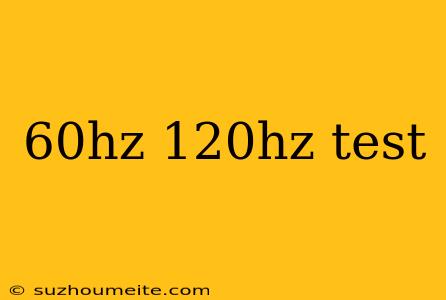60Hz vs 120Hz Test: What's the Difference?
When it comes to displays, one of the most debated topics is the refresh rate. Two of the most common refresh rates used in modern displays are 60Hz and 120Hz. But what's the difference between these two, and how do they affect your viewing experience?
What is Refresh Rate?
Before we dive into the specifics of 60Hz and 120Hz, let's quickly define what refresh rate is. Refresh rate refers to the number of times a display updates the image on the screen per second. It's measured in Hertz (Hz), and a higher refresh rate means a smoother and more seamless visual experience.
60Hz: The Standard
The 60Hz refresh rate is the most common and widely used refresh rate in modern displays. It's the standard refresh rate for most TVs, monitors, and mobile devices. At 60Hz, the display updates the image 60 times per second, which is sufficient for most everyday tasks like browsing, watching videos, and playing casual games.
Pros of 60Hz:
- Power Efficiency: 60Hz displays consume less power compared to higher refresh rate displays, making them more energy-efficient.
- Cost-Effective: 60Hz displays are generally cheaper to produce and purchase than higher refresh rate displays.
Cons of 60Hz:
- Limited Smoothness: 60Hz can struggle to provide a smooth experience, especially in fast-paced content like games and action movies.
- Motion Blur: 60Hz can suffer from motion blur, which can make fast-moving objects appear blurry.
120Hz: The Upgrade
The 120Hz refresh rate is a significant upgrade from the standard 60Hz. It updates the image 120 times per second, providing a much smoother and more responsive visual experience. 120Hz displays are typically used in high-end TVs, gaming monitors, and some mobile devices.
Pros of 120Hz:
- Smoother Experience: 120Hz provides a much smoother and more responsive experience, making it ideal for fast-paced content like games and action movies.
- Reduced Motion Blur: 120Hz reduces motion blur, making fast-moving objects appear clearer and more defined.
Cons of 120Hz:
- Higher Power Consumption: 120Hz displays consume more power compared to 60Hz displays, which can increase energy costs.
- Higher Cost: 120Hz displays are generally more expensive to produce and purchase than 60Hz displays.
The Verdict: 60Hz vs 120Hz Test
In conclusion, the 60Hz vs 120Hz test ultimately comes down to your personal preferences and viewing habits. If you're a casual user who mainly uses their display for everyday tasks, a 60Hz display may be sufficient. However, if you're a gamer or enjoy fast-paced content, a 120Hz display is definitely worth considering.
Test Results:
- 60Hz Test: 60Hz displays are suitable for casual use, but may struggle with fast-paced content.
- 120Hz Test: 120Hz displays provide a much smoother and more responsive experience, making them ideal for gaming and fast-paced content.
Remember, the refresh rate is just one aspect to consider when choosing a display. Other factors like resolution, panel type, and response time also play a crucial role in determining the overall viewing experience.
